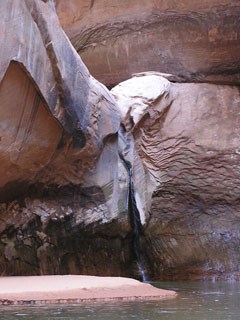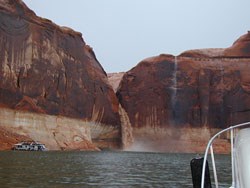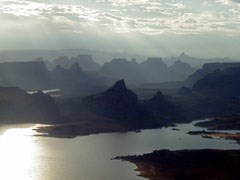|
Drive the long stretches of highway that cut through the Colorado Plateau to Glen Canyon National Recreation Area (NRA) and it will be hard to miss the colorful bluffs, mesas, buttes, and canyons that dominate the landscape. Glen Canyon NRA lies in the middle of the Colorado Plateau, which spans 130,000 square miles of Utah, Arizona, Colorado, and New Mexico, an area that can be characterized by its high elevation and arid to semi-arid climate. Take some time to explore this vast landscape, and you will find cryptobiotic soil crusts, lush hanging gardens, and traces of dinosaurs that roamed this area millions of years ago during the Mesozoic Era.

NPS/John Spence The environmental processes such as climate change, fire regime, weather, and geological processes that shaped the Colorado Plateau are recorded in rock formations, which are the storytellers of the region’s history. Canyons carved out by the Colorado River and its tributaries expose rock layers deposited on top of each other over time; the youngest rocks at the top and the oldest at the bottom. These rock layers reveal fossils and traces of past life forms, principally from the Mesozoic Era, 248 to 65 million years ago. Fossils preserved in the rocks of Glen Canyon NRA are evidence of the life and changes that occurred during the Mesozoic Era and add to our understanding of biodiversity and evolutionary history. Natural erosion, flash floods which accelerate erosion, illegal collection, and vandalism threaten the paleontological resources of this region. The geologic formations of the Colorado Plateau also affect vegetation communities by forming different soils and constraining water flow. Lush hanging gardens cling to vertical cliff walls and are fed by springs which flow down through porous rocks and cracks, until the water reaches a less permeable layer of rock when it begins to move sideways. The water may eventually reach the walls of a canyon where it seeps out of the rock and flows down, allowing plants to grow directly on the cliff face and on the ground around the seep. Though hanging gardens cover less than 0.1% of Glen Canyon’s 1.2 million acres, they are especially biologically diverse and support at least 10 endemic species, which are unique to the Glen Canyon area. The types and abundance of plants and animals in deserts are directly related to water. With limited water sources, many plant species, associated terrestrial invertebrates, aquatic invertebrates, birds, mammals, and amphibians use hanging gardens. Erosion caused by human and livestock foot traffic can increase the risk of invasion by nonnative species. Changes in regional precipitation patterns caused by global climate change could also threaten hanging gardens. 
NPS/Mark Anderson 
NPS Though the waters of Lake Powell, created by the completion of the Glen Canyon Dam in 1963, covered fossils and drowned hanging gardens and other vegetation and animal communities, these unique natural features can be found elsewhere in Glen Canyon NRA. The continued protection and preservation of these unique resources will contribute to the changing diversity of the ecosystem and biological communities of the Colorado Plateau and Glen Canyon NRA. The 1.2 million acres of the Colorado Plateau protected by Glen Canyon NRA provide abundant scientific research opportunities that contribute to our understanding of these unique resources. Published 8/07
|
Last updated: June 18, 2024



